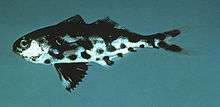Man-of-war fish
| Man-of-war fish | |
|---|---|
 | |
| Scientific classification | |
| Kingdom: | Animalia |
| Phylum: | Chordata |
| Class: | Actinopterygii |
| Order: | Perciformes |
| Family: | Nomeidae |
| Genus: | Nomeus G. Cuvier, 1816 |
| Species: | N. gronovii |
| Binomial name | |
| Nomeus gronovii (J. F. Gmelin, 1789) | |
| Synonyms | |
| |
Nomeus gronovii, the man-of-war fish, is a species of fish in the family Nomeidae, the driftfish. It is native to the Atlantic, Pacific and Indian Oceans, where adults are generally found at depths from 200 to 1,000 m (660 to 3,280 ft). It is notable for its ability to live within the deadly tentacles of a siphonophore, the Portuguese man o' war, upon whose tentacles and gonads it feeds. The fish is striped with blackish-blue blemishes covering its body, and the caudal fin is extremely forked. It can reach a length of 39 cm (15 in). It is of minor importance to commercial fisheries. This species is the only known member of its genus.[2]
Toxin avoidance
Rather than using mucus to prevent nematocysts from firing, as is seen in some of the clownfish sheltering among sea anemones, the fish appears to use highly agile swimming to physically avoid tentacles.[3][4]
The fish has a very high number of vertebrae (41), which may add to its agility[4] and primarily uses its pectoral fins for swimming—a feature of fish that specialize in maneuvering tight spaces. It also has a complex skin design and at least one antigen to the man o' war's toxin.[4] Although the fish seems to be 10 times more resistant to the toxin than other fish, it can be stung by the dactylozooides (large tentacles), which it actively avoids.[3] The smaller gonozooids do not seem to sting the fish and the fish is reported to frequently "nibble" on these tentacles.[3]
References
| Wikimedia Commons has media related to Nomeus gronovii. |
- ↑ Dooley, J. 2015. Nomeus gronovii. The IUCN Red List of Threatened Species. Downloaded on 19 February 2016.
- ↑ Froese, Rainer and Pauly, Daniel, eds. (2014). "Nomeus gronovii" in FishBase. February 2014 version.
- 1 2 3 Jenkins, R. L. (1983): Observations on the Commensal Relationship of Nomeus gronovii with Physalia physalis. Copeia, Vol. 1983, No. 1 (Feb. 10, 1983), pp. 250-252
- 1 2 3 Purcell, J. E. & M. N. Arai (2001): Interactions of pelagic cnidarians and ctenophores with fish: a review. Hydrobiologia, May 2001, Volume 451, Issue 1-3, pp 27-44

.gif)
